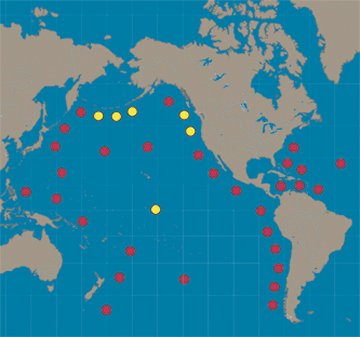On Jan. 14, the Bush administration announced a $37.5 million program to expand the nation’s tsunami-warning capabilities. The 2-year plan includes placing tsunami-detecting buoys in the Atlantic Ocean and Caribbean Sea as well staffing around the clock the existing tsunami-warning centers in Alaska and Hawaii. The plan comes on the heels of last month’s earthquake-triggered tsunamis that killed at least 160,000 people on shores rimming the Indian Ocean (SN: 1/8/05, p. 19: Tsunami Disaster: Scientists model the big quake and its consequences).

Currently, the National Oceanic and Atmospheric Administration (NOAA) operates a six-buoy warning system in the Pacific Ocean (SN: 3/6/04, p. 152: Killer Waves). That’s where 85 percent of the world’s tsunamis occur, but the massive waves are known to have struck every marine region except the Arctic Ocean. Earthquakes, undersea landslides, volcanic eruptions, and even meteor strikes can trigger tsunamis.
About $13.8 million of the funding announced last week will be spent to procure and install 32 pressure sensors on the seafloor to detect passing tsunamis and measure their heights in the open ocean. A buoy near each sensor will relay the information to scientists.
Most of the equipment will be installed around the rim of the Pacific, but seven of the buoys will be deployed in the Atlantic and Caribbean, which aren’t now monitored for tsunamis. Although tsunamis in those bodies of water are less frequent than in the Pacific, they aren’t unknown. On Nov. 1, 1755, waves spreading from three quakes that occurred beneath the eastern Atlantic destroyed Lisbon, Portugal (SN: 1/3/04, p. 14: Available to subscribers at
Newfound fault may explain quakes), and inundated some areas of several Caribbean islands. In October 1918, a tsunami triggered by a magnitude 7.5 temblor near Puerto Rico killed 40 people there.
The proposed system should “provide the U.S. nearly 100 percent coverage” for incoming tsunamis and reduce false alarm rates to nearly zero, says John H. Marburger III of the White House’s Office of Science and Technology Policy. Before the current system was installed, three-quarters of tsunami warnings turned out to be unnecessary.
About 150 million people live in U.S. coastal areas (SN: 3/27/04, p. 197: Coastal Surge: Ecosystems likely to suffer as more people move to the shores), and more than 180 million people vacation there, notes Conrad C. Lautenbacher Jr., NOAA’s administrator.
Other important initiatives in the new plan include procuring, operating, and maintaining 38 new shore-based tide-gauge stations, upgrading 20 seismometers used to measure earthquakes, identifying shorelines along the Atlantic Ocean and Gulf of Mexico that would be particularly susceptible to tsunamis, and boosting community preparedness in coastal areas.
Although existing budgets included funding for many of these initiatives, Lautenbacher admitted that last week’s proposed acceleration of their implementation wouldn’t have occurred but for the horrendous toll of last month’s tsunamis in the Indian Ocean.






